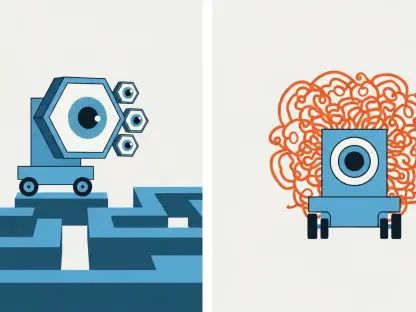In today’s rapidly evolving technological landscape, artificial intelligence (AI) plays an increasingly significant role in numerous applications, including emotion detection. Understanding human emotions from text is pivotal in areas like mental health support, empathetic dialogue systems, and customer service. However, a critical challenge remains in aligning AI’s interpretation of emotions with the actual emotional states of individuals. Recent research by Pennsylvania State University sheds light on the discrepancies between third-party interpretations and self-reported emotions, questioning the reliability of current methods used in training AI models for this task. The study delves into the potential of demographic insights to enhance the accuracy of emotion detection by examining the role of shared demographic traits in bridging this gap.
The Challenge of Third-Party Emotion Annotations
Discrepancies in Emotional Interpretation
The assumption that third-party annotations align with an author’s genuine emotions remains a foundational concept within Natural Language Processing (NLP) tasks. The research initiated by Pennsylvania State University critically evaluates this prevalent assumption. The focus has been on analyzing the differences between self-reported emotions and third-party interpretations—both by humans and large language models (LLMs). Sarah Rajtmajer, one of the study’s senior authors, emphasized the importance of acknowledging these discrepancies beyond trivial labeling errors, warning of potential socially harmful repercussions in downstream applications if they are allowed to proliferate unchecked. The exploration of third-party emotion annotations highlights the necessity for precise identification of emotional perspectives, opening the door to more nuanced AI models that recognize the complexity intrinsic to human emotions.
The underscored challenge was the misalignment often noted in emotion recognition, whereby third-party annotators find it difficult to reliably identify the emotional states conveyed through text. This issue is increasingly relevant given the reliance on datasets annotated by humans to train LLMs. Ph.D. student Jiayi Li spearheaded the exploration into text-based emotion recognition, focusing particularly on chat interfaces and other AI platforms regularly employed to process written content. Li’s research raises essential questions about the reliability of traditional annotation practices, mapping the intricacies of emotions more thoroughly encountered in real-world applications, and proposing novel solutions to overcome the prevalent discrepancies.
Impact on AI-Driven Applications
The research extends its scope to evaluate the vast impact of inaccurate emotional interpretation on AI-driven applications. An ongoing issue is that machines trained on potentially flawed datasets might lead to responses misaligned with users’ actual emotional intentions. This inaccuracy can be particularly damaging in sensitive fields like mental health, where empathy and precise understanding of emotional states are crucial for effective support. The larger implication of these discrepancies also touches customer service scenarios, affecting the user experience and ultimately a company’s relationship management. The consequences are not limited to private interactions but could ripple out to societal levels, making the issue one of ethical consideration for businesses deploying such technology.
AI platforms, when properly attuned to demographic similarities, potentially improve the precision of emotion detection. This aspect of research reflects a growing awareness among AI experts regarding the crucial necessity of nuanced emotional recognition systems. The team’s investigation into how demographic context might aid emotion recognition offers promising insights toward achieving AI that understands users better. As misalignments could lead to socially harmful consequences, a call for more refined models becomes increasingly pressing, focusing on capturing real emotional states instead of observer bias. Thus, correcting the trajectory of AI’s development in emotion detection invites broader conversations on ethical AI implementation.
Leveraging Demographic Insights for Improvement
Demographic Context in Annotation
Pennsylvania State University’s research marked a breakthrough by unveiling the potential for demographic context to enhance emotion detection accuracy. A key component of this exploration involved conducting experiments with social media users, leveraging the crowdsourcing platform Connect. Participants shared personal posts, tagging them with emotions they believed they were expressing. Human annotators, categorized according to demographic similarities—such as age and ethnic background—then analyzed these posts. Furthermore, several LLMs participated in the same annotation task, promoting an experimental method of inferring emotions through shared demographic traits.
This approach sparked intriguing results, indicating that individuals with shared demographics better recognized each other’s emotions than those from disparate backgrounds. The hypothesis that people with common demographic features can more accurately ascertain each other’s emotional states found substantial support. The study revealed slight but statistically important alignment improvements when LLMs integrated demographic context into their analysis. This insight poses a potential avenue for AI to advance in emotion detection, suggesting that demographic alignment may serve as a key catalyst in refining AI’s ability to interpret human emotions accurately.
Implications for Future NLP Models
The exploration of demographic context offers compelling implications for the development and refinement of future NLP models. By integrating demographic insights into training datasets, AI systems can potentially achieve a higher degree of emotional alignment with user experiences. This understanding promotes the creation of empathetic dialogue systems, crucial for mental health applications, where recognizing genuine emotional states significantly enhances support interventions. Furthermore, LLMs stand to benefit from having a nuanced understanding of emotional expression, potentially leading to enriched user interactions across various platforms that incorporate emotional intelligence.
Researchers at Pennsylvania State University advocate for forward-thinking NLP models that extend beyond basic emotional categories and rigidly constructed taxonomies. The study implies creating models that infuse flexibility and broaden applicability, addressing emotional recognition complexity inherent in ever-evolving human language and its subjective nuances. Moving forward, AI developers may explore incorporating demographic context as standard practice, forging pathways for AI that more accurately responds to the richness and diversity of human emotion. Emphasizing hypothetically shared experiences within demographic groups encourages innovative methodologies for improving NLP systems and ensures that AI serves humanity with greater empathy and accuracy.
Refining Emotion Detection in AI Technologies
Challenges in Aligning Emotional Perspectives
The study’s findings underscore the necessity of distinguishing whose emotional perspective AI captures in emotion detection tasks—whether the author’s or the observer’s. Incorrectly aligning these perspectives could hinder applications like mental health support systems, which demand an accurate understanding of emotional expressions to provide effective assistance. For AI-driven technologies to genuinely support users, they must advance to a point where emotional recognition is precise and contextually aligned. The challenge lies in designing systems capable of discerning real emotions through text while steering clear of misalignments that might result in erroneous conclusions.
Pennsylvania State University’s study directs attention to developing models that consciously incorporate varying perspectives, sharpening AI’s capability to interpret emotions with a heightened sense of empathy. By grounding models in users’ actual sentiments rather than observers’ interpretations, researchers aim to close the gap between current AI limitations and potential applications. The goal is to foster NLP systems that appreciate human diversity and emotional complexity, transforming AI from mere textual analyzers to empathetic interlocutors, adept at understanding and responding to nuanced human emotions. This advancement may set a benchmark for subsequent research into emotion recognition, offering professional practices stepping stones toward more refined AI technologies.
Expanding the Horizons of NLP
The study implicates a broader horizon for NLP, accentuating the critical need for more sophisticated and user-centric emotion recognition models. As technology evolves, AI’s role will likely extend into realms requiring deeper emotional understanding. The research presents a pioneering view of text-based emotion recognition, advocating for models responsive to the organic nature of human emotions. This orientation could eventually lead to AI systems cognizant of not just the explicit but also the implicit emotional cues present in language, reshaping interactions across digital platforms.
Researchers express enthusiasm about developing future NLP models that transcend traditional boundaries, paralleling the organic growth of human emotion understanding. Such models would actively address the complexities associated with emotion recognition, providing broader applicability in diverse scenarios. The study points toward future explorations eager to excavate emotional subtleties, integrating shared experiences as a lever for improving AI’s grasp on human language. The commitment to refining emotion detection projects imagines AI’s evolution in alignment with authentic human expressions, fostering harmony between machine intelligence and human emotional complexity.
Looking Forward to Enhanced Emotion Recognition
The presumption that third-party annotations mirror an author’s authentic emotions is a key principle in Natural Language Processing (NLP). Pennsylvania State University research challenges this assumption, examining disparities between self-reported feelings and interpretations by humans and large language models (LLMs). Senior author Sarah Rajtmajer highlights the need to address these differences, warning of harmful effects in applications if not rectified. These findings underline the need for accurately targeting emotional viewpoints, paving the way for sophisticated AI models that better grasp human emotional complexity.
The research illuminates a recurrent challenge—misalignment in emotion recognition—where third-party annotators often struggle to consistently identify emotions depicted in text. This concern grows with reliance on human-annotated datasets to train LLMs. Ph.D. student Jiayi Li leads inquiries into emotion recognition, particularly in chat interfaces, raising significant issues about the trustworthiness of established annotation methods and suggesting innovative approaches to address common discrepancies.









